Do you have questions on how to use Samooha’s GOOMI application or have an issue?
Please check the FAQ (Frequently Asked Questions) here first before you write to or call us and wait for response. You may instantly find answers to your questions here.
General Topics
Help! I don't know how to create this document / transaction!
Samooha have made available many resources online on our Technical Library. User can find manuals, videos, articles, and flowcharts to help them use the GOOMI application. Click on the Help ![]() button on the top left corner of each document / transaction view.
button on the top left corner of each document / transaction view.
Samooha also provides training courses for our users, from general company users, to in-depth training sessions for administrator and accountants.
For any queries, please contact us at:
Tel: +65 6702 3400
Email: [email protected]
What are the differences between Drafted, Confirmed, Approved, and Posted document status?
Document created within a structured organization have different status to indicate the state it is in.
In GOOMI, there are 4 common status for documents:
- Drafted: all newly created documents start with Drafted status. User can edit the content of the document until it is confirmed.
- Confirmed: the document content have been completed. It is now waiting for approval / posting.
- Approved: the document has been approved by the approving authority.
- Posted: the document has been reviewed and posted to the accounts / inventory to update the accounting entries / inventory records.
There is also Closed status for some master record / transaction document. To close a record / document, user requires access right enabled to use it.
- Master record: i.e. Chart of Accounts, Customers, Employees, Warehouse, etc.
This allow user to deactivate / disable the record from being use for any transaction. User able to reopen the record if need to re-activate the record for transaction usage - Transaction document: i.e. Sales Order
This allow user to close a pending / cancelled Sales Order and to keep the document as record purpose.
Note: some conditions may need to be fulfilled before user able to close a record / document. For example, to close a Warehouse master record, the warehouse need to be empty (no stock).
Why can't I click the save button after I filled up transaction document information?
Please ensure that you have filled up all mandatory information, marked with a red text field and / or red cross (x) at the bottom left of the text field.
Some transaction document may requires user to enter description. Try enter a simple description.
Some actions may have triggered the save function, for example when user added a product line by pressing ENTER or click ![]() button
button
I don't see the changes I made to a document after saving it, is it not saved?
Please try any of the following to refresh the document:
1. Click ![]() or “Refresh” button on top of the screen
or “Refresh” button on top of the screen
2. Click on the element (document view / textfield / list) and press F5 button to refresh the content
3. Close the document view and reopen it
4. Close GOOMI application, reopen the application and login
Why is Reference Number mandatory? What information should I enter for it?
Most documents in Samooha have reference number info to:
- Link / reference the document with another (source / subsequent) document(s)
- Allow user to enter additional information for easier search / overview in list view and reports
- Allow user to enter info as reference to a document outside of GOOMI system, for example user can enter PO number from their customer in the Sales Order as Reference Number.
Note: user can enter any info like “-” or “NA” (Not Available) in the Reference Number field if they do not require any info to be entered in this field.
I can't find a document, is it missing?!
Why the data I tried to export to csv file seems to be incomplete / less than what I have?
Samooha list view export only data shown / filtered in the list user interface view. If use has entered any filter or search keyword(s), user will only be able to export the listed lines.
For example: if user entered a keyword in the search engine filter, the exported file will only contain the results of the filtered list view
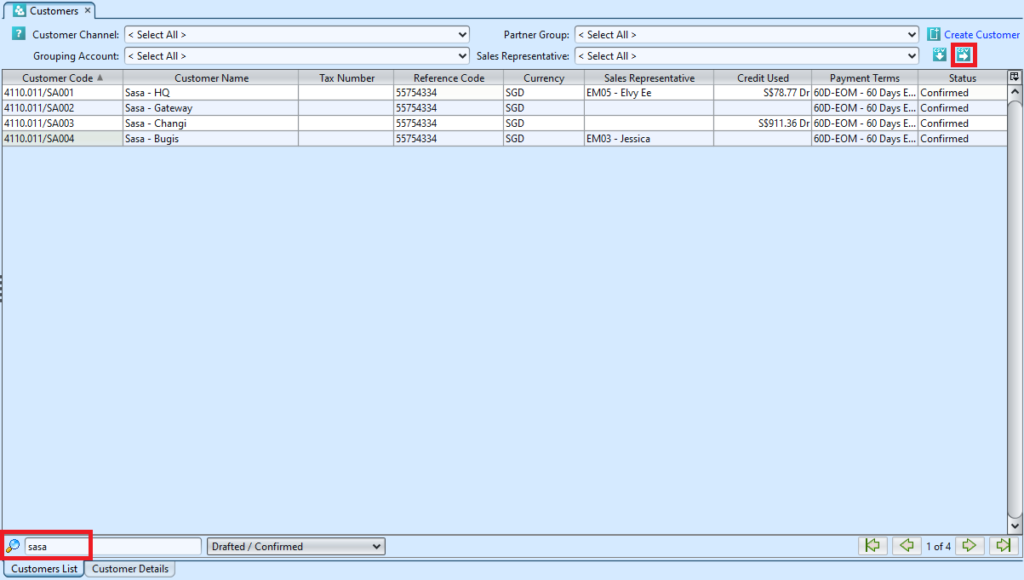

Samooha list view also has filter by page (pagination feature). If user would like to export ALL data, user will need to disable the pagination feature first. Right-click on the numbers at the bottom right to disable the pagination feature.
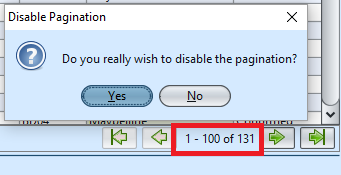
Note: Please be advised that if user have thousands of records to export, it may take a while to write the data into csv file. During the data export processing, both Samooha application and the csv file may not be accessible.
Why the year (for dates) I tried to import using csv file was showing 0017 instead of 2017? Why some dates don't get imported when using the csv file import feature even though I have followed the csv export file's date format?
This date format issue is unfortunately was a default date format setting by Microsoft Windows Operating System, which was used by Microsoft applications like Excel. When user open the csv file using Excel, the application will change the date format to follow this default format.
Generally Microsoft default date format is: dd/MM/yy (for UK region) OR MM-dd-yyyy (for US region)
For example, 2nd January 2018 will be:
1. dd/MM/yy = 02/01/18
2. MM-dd-yyyy = 01-02-2018
Samooha is using UK date format but with 4-digits for year, to support 19xx & 20xx years in the Samooha dates.
Samooha date format for csv import are:
1. For document dates: dd/MM/yyyy (i.e. 02/01/2018).
2. For manufacturing or expiry dates: dd-MMM-yyyy (i.e. 02-JAN-2018).
To change the data date format in Excel for Samooha csv import, users have 2 options:
- Select all the dates in the csv files in Excel, and change the date format to dd/MM/yyyy or dd-MMM-yyyy.
This have to be done whenever user open / reopen the csv file, as Excel will change the dates’ format back to the default one.
OR - To ensure year format is always in 4-digits, change the Windows Operating System default date to dd-MMM-yyyy.
Please follow the following steps in this article: Change Date Format in Windows 7, 8.1 and Windows 10 to dd-mm-yyyy
Accounts Topics
I cannot post a document, system prompted message 'The fiscal period for the selected document date has been closed!'
Accounts will need to open the fiscal period of the document date to allow posting of documents / transactions.
Use “Accounts (Masters) – Fiscal Calendar” to open / update the fiscal period.
I cannot post a document, system prompted message 'The currency exchange rate are not updated for this period! Please update the exchange rates in the currency master.'
Accounts will need to update currencies exchange rates for the specific period (that covers the document’s date) to allow posting of documents / transactions that use other currencies than the base currencies.
Use “Accounts (Masters) – Currencies” to update the currencies exchange rates.
Why do I get "(Reference Number Already Use)" error message while posting for Non Trade Invoice & Debit Note documents?
The reference number in purchase documents can not be used twice with a single vendor account. This would mean, for the same vendor invoice, the document is being created/posted twice.
If the reference number is suffixed with an additional character (Like, A, B C….), then posting should work as usual.
I have created new / made changes to the accounts settings (Inventory module) but there is no changes to the transaction document's postings
After creating new account settings or making any changes to accounts selection in the accounts settings (Inventory module), user will need to add / update the account settings.
Right-click on the new / modified account setting to see the option to do so.
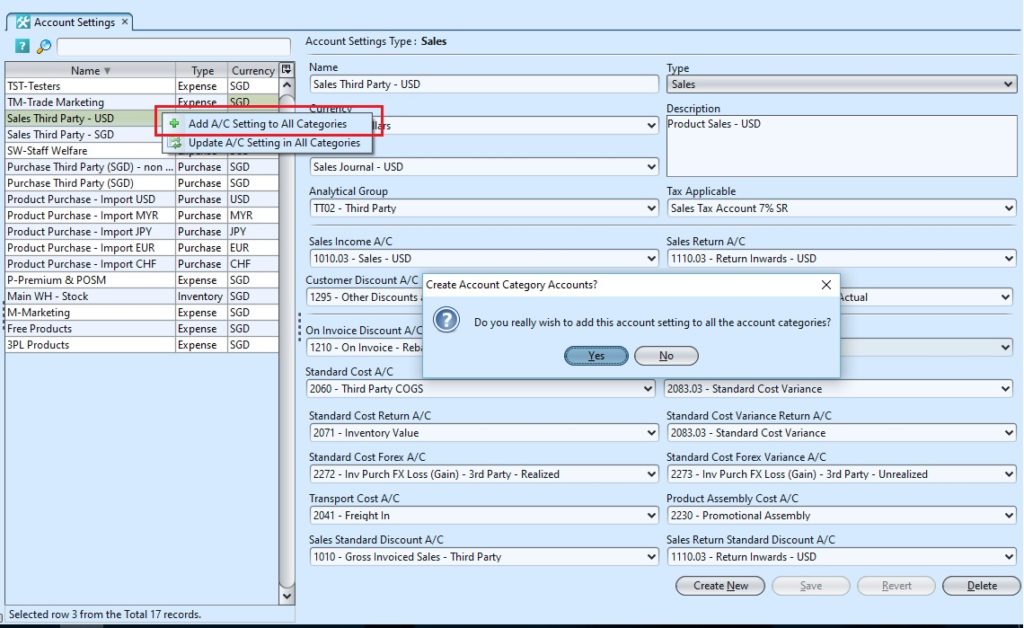
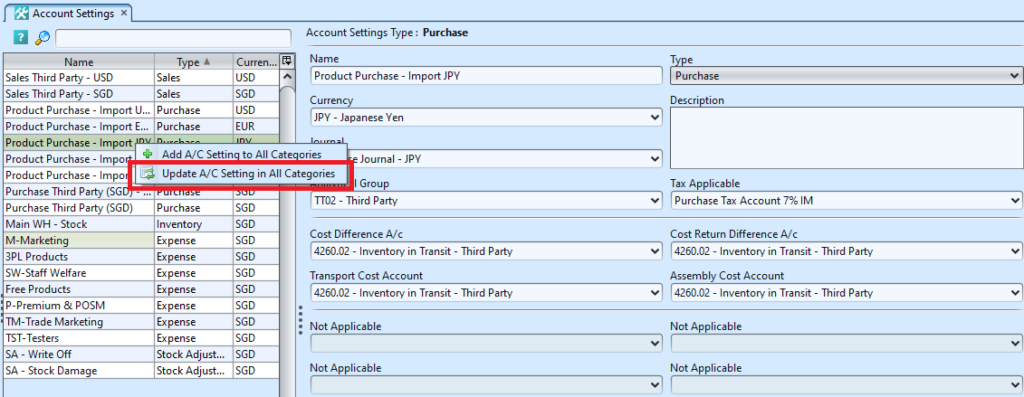
See “Inventory (Masters) – Account Settings” for more details.
Why I cannot delete a Non Trade Invoice document?
Check if the following 2 conditions were fulfilled:
- The document status is drafted
- User have access to delete Non Trade Invoice document
For Non Trade Invoice document that was generated by Expense Requisition (Purchase module), user will need to undo posting of the source Expense Requisition document to delete the corresponding Non Trade Invoice document.
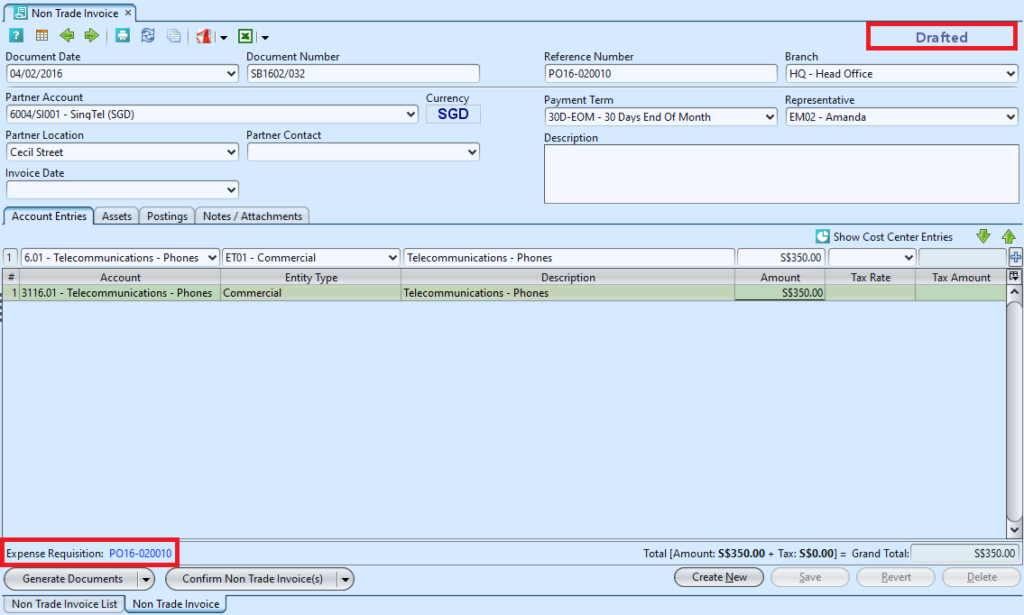
Distribution Topics
When is a product's stock inventory status is "Reserved"?
There are 3 types of stock reservation in Samooha:
A. Reserve Quantity.
For this type of reservation, the system will reserve quantity of the product, no batch / lot is reserved.
Transactions that use this type of reservation i.e. Consignment Order, Warehouse Order, Product Assembly / Disassembly.
B. Reserve Batch / Lot.
For this type of reservation, the system will reserve specific batch / lot of the product. Quantity reservation generally done in the preceding document.
Most inventory / logistics transactions reservation of batch / lot are done in Picking when it is started.
C. Reserve Quantity AND Batch / Lot.
For this type of reservation, the system will reserve quantity of the product and specific batch / lot of the product.
Currently only Sales Order use this type of stock reservation.
The stage at which products were reserved in transaction documents:
- For FEFO Picking Method, after Sales Order document containing the product is confirmed. When the product is picked (Picking document is Posted), the status will change to “Staging”
- For FIFO Picking Method, after Picking process containing the product is confirmed. When the product is picked (Picking document is Posted), the status will change to “Staging”
- After Debit Note document (with inventory movement) containing the product is confirmed. When the product is picked (Picking document is Posted), the status will change to “Staging”
- For Point-of-Sale (Cash Register), after POS is Closed containing the product (POS tickets are Confirmed). When the consolidated Point Of Sale document is Posted, the product will be removed from inventory (sales completed)
When is a product's stock inventory status is "In-Transit"?
Product’s stock inventory status is “In-Transit” when:
- Purchase Invoice, containing the product, has been posted but Goods has not been received yet
- Credit Note has been posted (Customer is credited for the return product) but the product that Customer Return has not been received yet
Why I can't find the customer(s) I want to assign for my Sales Price List / Trading Terms?
First of all, ensure that the customer record is confirmed / not closed.
Customer record has 2 settings that define its Sales Price List / Trading Terms usage:
- Checkbox: Price Includes tax
When this checkbox is ticked, the customer will only be shown in “Customers List” of the Sales Price List & Trading Terms that includes tax. Otherwise it will be shown in “Customers List” of the Sales Price List & Trading Terms that excludes tax
- Price List Type: “Price List” or “Trading Terms”
When “Price List” is chosen, the customer will only be shown in “Customers List” of the Sales Price List.
If “Trading Terms” is chosen, the customer will only be shown in “Customers List” of the Trading Terms.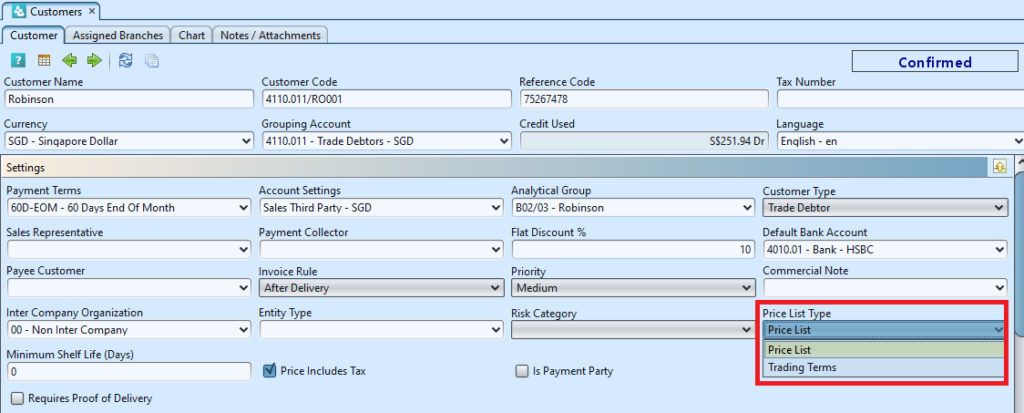
For example:
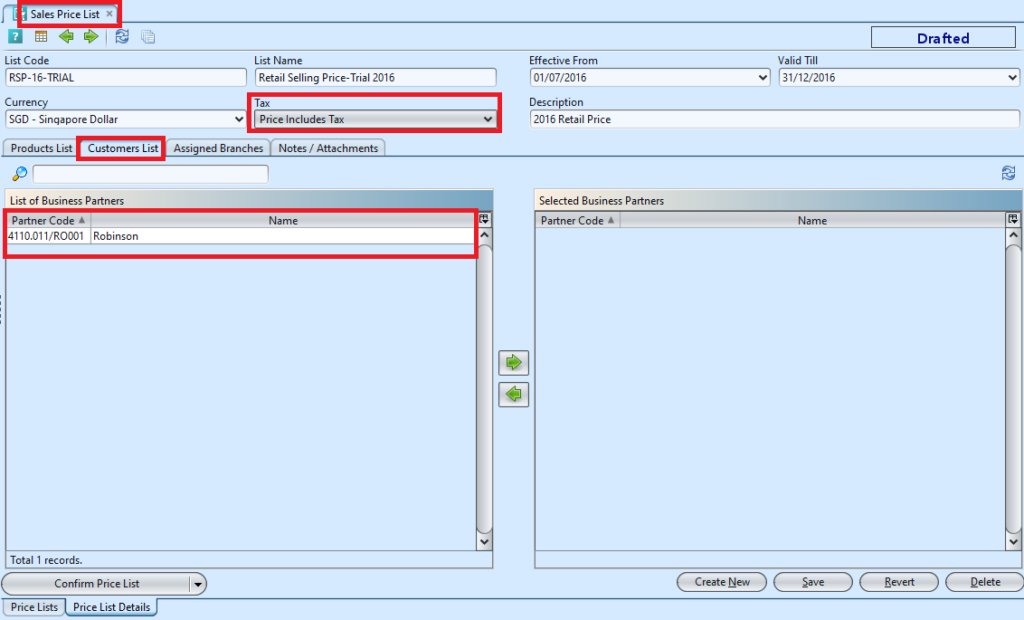
Point of Sales Topics
Why I can only see ticket history from one cash register counter? How to view all / other cash register counters' ticket history
If user’s computer was assigned to a Cash Register, user will only able to view Ticket History from the assigned Cash Register.
To view all Cash Registers Ticket History, user will need to un-assigned their computer from being linked with any of the Cash Register. Follow the following steps to do so:
- Open POS (Masters) Cash Register
- Select the Cash Register then click “Show Details” button
- Check if the same value in “Assigned Mac Address” and “System Mac Address”. If so click “Clear Address” button to un-assign the Cash Register. This will allow user to view ALL Cash Register tickets in Ticket History.Note: If the Point of Sales (Cash Register) is opened, user will need to close POS first from the Point of Sales Entry, before they are able to un-assign the Cash Register.
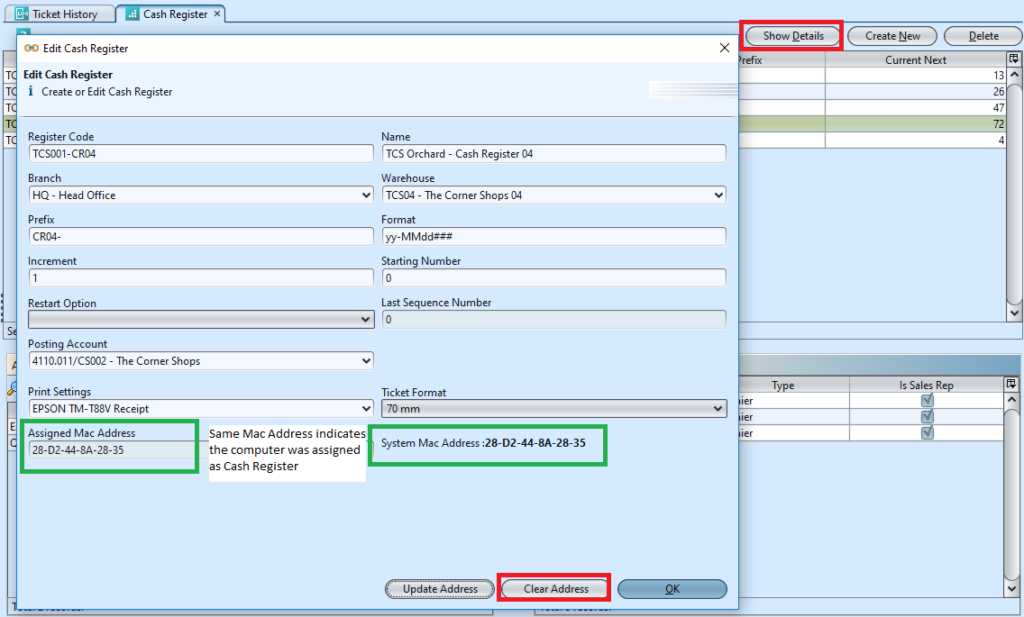
- Open Ticket History




